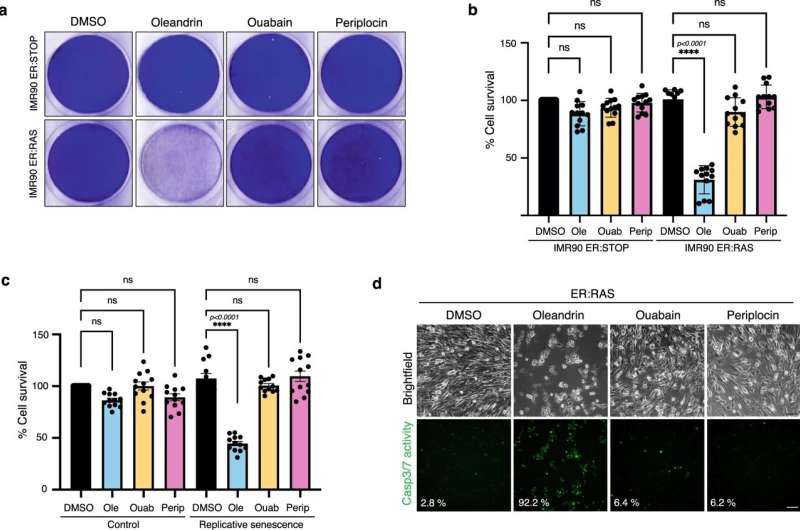June 16, 2023 report
This article has been reviewed according to Science X's editorial process and policies. Editors have highlighted the following attributes while ensuring the content's credibility:
fact-checked
peer-reviewed publication
trusted source
proofread
Researchers follow AI path to safer senolytic compounds

Researchers from the University of Edinburgh, Scotland, and the University of Cantabria, Spain, have teamed up to develop an AI trained to discover senolytic medicinal chemistry in familiar compounds.
In the paper, "Discovery of senolytics using machine learning," published in Nature Communications, the researchers detail the efforts to search over 4,300 scientifically described compounds for the right chemical makeup to address cellular senescence.
Cellular senescence is what happens when a cell stops multiplying. This can be from age, where a cell may self-determine that there are too many accumulated mutations to replicate safely or because the cell has been damaged. Senescence plays an essential role in limiting tumor progression by not allowing damaged or mutated cells to proliferate.
The body can tolerate having a few non-participating senescent cells in a tissue. Accumulating high levels of senescent cells with age is associated with various forms of disease—osteoarthritis, lung disease, Alzheimer's, dementia and cancer.
The screening method used 58 previously identified senolytics and 2,465 compounds known to have no senolytic effects to train the AI. After sufficient training, the AI was introduced to libraries containing 4,340 FDA-approved or clinical-stage compounds.
Three senolytic compounds identified in the study are found in herbal medicines. Testing on human cells revealed that all three, ginkgetin, periplocin and oleandrin, were able to remove senescent cells without damaging healthy cells.
One of the three stood out from the others, oleandrin, as the most promising. Oleandrin is a compound in the class of cardiac glycosides which are often used as a heart medication to increase cardiac output during heart failure and in the treatment of hypotension and arrhythmias.
The leading cardiac glycoside compound in use currently is ouabain, known to have relatively high toxicity and is a common cause of poisoning. In fact, ouabain is a crucial component of poison arrows used by Maasai warriors in Kenya.
Oleandrin showed a greater senolytic performance over ouabain, functioning at a low nanomolar range, inhibiting its canonical target and activating its senolytic pathway with higher efficacy. Oleandrin did not affect the viability of normal cells at the tested concentrations, all indicating promising senolytic potential.
Cardiotoxicity is still a concern with oleandrin. The researchers suggest that being used directly on the site of damaged tissue as a localized senolytic therapy might make it an impactful treatment while reducing offsite risks, and clinical trials are currently assessing such local administration of senolytics for osteoarthritis.
In a parallel effort, the researchers show that ex-vivo senolytics perfusion of human transplant livers preserves tissue architecture and regenerative capacity during cold storage.
The study used existing data to uncover previously unknown knowledge. While the actual research findings offer an exciting new compound to test in overcoming cellular senescence, it is also another example of the beneficial contribution AI can make in the hands of researchers.
More information: Vanessa Smer-Barreto et al, Discovery of senolytics using machine learning, Nature Communications (2023). DOI: 10.1038/s41467-023-39120-1
Journal information: Nature Communications
© 2023 Science X Network





















